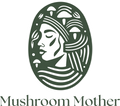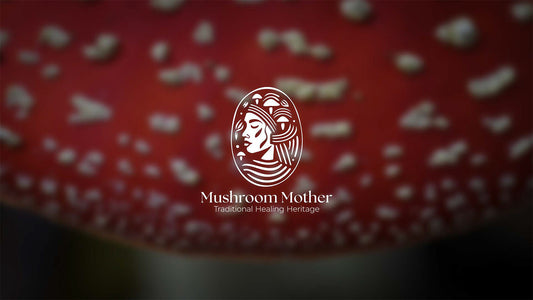This is not just a question of “can we or can’t we”. We may hear it as an ancient call to reclaim sovereignty over the body and knowledge, over birth, life and death. There is fire in this topic that warms others, that lights a path.
At this stage of the path we know:
- In Nigeria, Mexico, Siberia and the North mushrooms were present as medicinal spirit and companion. They were boiled, drunk, inhaled, carried in amulets. Before, after and during birth. Sometimes simply placed nearby for their presence. They required reverence and listening. Women always knew when the mushroom called.
- Modern science discourages the use of certain powerful mushrooms during pregnancy or lactation due to the lack of clinical trials, not necessarily because of proven harm, but because of legal and ethical limitations on research involving pregnant women. This has created a gap where caution is framed as prohibition. Women, midwives and herbalists often must rely on traditional knowledge, case studies and personal experience.
- As a woman who works with the body and pregnancy, I’ve known midwives and doulas who used psychoactive mushrooms during labor. They say the mushroom helps open and surrender, and "expel" the baby easily. It is not a universal advice. It is worked out with each woman individually, in each moment.
- There are mushrooms that work as gentle allies in sensitive chapters, as invitations to restore. Cordyceps can offer energy and resilience, supporting breath and hormones softly. Maitake may help regulate blood sugar and inner balance. Reishi brings nervous system calm, deeper sleep and heart-centering presence. Turkey Tail is known to modulate immunity and support microbiome recovery after illness. Chaga nourishes deeply as a grounding antioxidant after stress and inflammation. And Lion’s Mane can be introduced for its neural wisdom.
- Resources like e-lactancia.org provide evidence-based safety profiles for substances during breastfeeding. Example: Reishi mushroom is "fairly safe, moderate use would be compatible with breastfeeding". https://www.e-lactancia.org/breastfeeding/reishi-mushroom/synonym/
- No one will hand us a paper with “approved” stamped on it. We must feel into what roots us and what ungrounds us. That is our task, yours and mine. To be the ones who listen deeper. Be honest, attentive, inspired and brave. Modern medicine has turned its back on ritual, body and earth, making the field of birth tabooed and distorted. The fear is too big, the control too strong. We do not have to play by those rules. We can be the generation that brings back the dialogue between spirit and science. The world says: “We don’t know, so you can’t.” And we ask: “Why don’t we know? Why don’t we want to know? Why don’t we trust the woman?”
Perhaps you are one of those who go where others won’t.
To find what was hidden.
To remember what was forgotten.
To return the right for women to be not only bearers of children but the keepers of knowledge.
Listen.
Traditional use of medicinal mushrooms in women's health, pregnancy and birth
1. Nigeria and West Africa
In Nigeria, particularly among the Yoruba and Igbo peoples, mushrooms have long been used in traditional medicine. They are known to treat ailments such as fever, asthma and skin diseases, and some records mention their use during pregnancy to support the health of the fetus.
"Ethnomycology and Usage of Edible and Medicinal Mushrooms Among the Igbo People of Nigeria", ResearchGate: https://www.researchgate.net/publication/247854948
Some mushrooms are used postpartum to restore vitality, though precise species and practices are typically transmitted orally among women and healers, and often remain undocumented in official texts.
Listen to: Babatunde Olatunji – Akiwowo
2. Sidama people of Ethiopia
Among the Sidama in Ethiopia, women and children are the primary mushroom gatherers. Wild mushrooms are used both as food and in folk healing. For instance, spores from Lycoperdon Perlatum and Calvatia Rubroflava are applied topically to treat wounds and skin conditions.
Source: "Ethnomycological Study of Wild Edible and Medicinal Mushrooms in the Sidama Zone of Southern Ethiopia", MDPI, 2020: https://www.mdpi.com/1999-4907/11/8/875
These practices form part of women’s responsibility for family care and health protection.
Listen to: Mulatu Astatke – Dung Gate
3. Central America, Mazatec and Mixtec traditions
In the sacred mushroom rituals of the Mazatec people (Oaxaca, Mexico), psilocybin mushrooms have been used for generations by curanderas (female healers) to treat emotional and physical imbalances. There are anecdotal accounts of women using them to prepare for childbirth: to listen to their bodies and ease emotional resistance.
Source: María Sabina’s oral accounts and curandera practices (documented in the work of R. Gordon Wasson)
Psilocybin Mushrooms of the World by Paul Stamets also references the ceremonial use by women as spiritual and physical support.
While not common during pregnancy, these rituals reflect a deep feminine connection to fungi as allies for transition and transformation.
Listen to: María Sabina – Chjon Nka
4. Northern cultures, Siberia and Arctic Tribes
Among the Chukchi, Evenki and other indigenous peoples of Siberia, Amanita Muscaria has been used ceremonially for centuries. Although mainly associated with shamanic journeys, there is reference to its use for physical recovery, including by women after birth for energy, clarity and ritual purification.
Source: "Shamanism in Siberia", Waldemar Bogoras (early 20th century ethnography)
The Sacred Mushroom and the Cross by John Allegro (contextual mention)
Much of this knowledge remains within the oral and spiritual traditions of these peoples, passed down in ceremony and song.
Listen to: Otyken – Pulse
Closing thought
The intersection of fungi and women’s health is as old as time and still under-researched. It is not just about pharmacology, it’s about relationship, listening, intuition and honoring the sacred role of the body during life’s thresholds.
This document is a beginning. Let’s keep uncovering.
Compiled by Eli & sister intelligence 🍄


